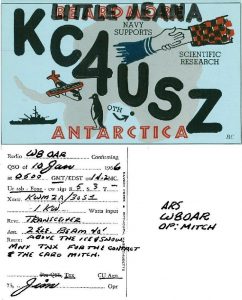 It was not an easy task to retrace the history of Little Jeana Station but thanks to our friend Bill Ashley KF5BRB who did provide a QSL ofthis rare one, WAP is now in condition to issue to LITTLE JEANA STATION (aka Little Jeana Summer Weather Station) a brand new WAP reference as USA-47.
It was not an easy task to retrace the history of Little Jeana Station but thanks to our friend Bill Ashley KF5BRB who did provide a QSL ofthis rare one, WAP is now in condition to issue to LITTLE JEANA STATION (aka Little Jeana Summer Weather Station) a brand new WAP reference as USA-47.
The KC4USZ card , prove that an activity on Jan. 10th 1966 from this epic rare one by a QSO made with W8OAR!
US Station Little Jeana.
The Bulletin of the Antarctic US Projects officer (Vol.6 number 2-1964), signed by Rear Admiral James R. Reedy, USN United States Antarctic Projects Officer, show a presentation of activities of the Government of the United States of America pertaining to the logistic support, scientific programs, and current events of interest in Antarctica, published monthly during the austral summer season and distributed to organizations, groups, and individuals interested in United States Antarctic activities.
The data in the over mentioned issues suggest that Little Jeana was active from 3 oct.64 to 23 feb.65, from 2 oct.65 to 31 oct.65 and again from 1 dec.65 to 22 jan.66.
SUMMER WEATHER STATIONS REESTABLISHED
Prior to the first aircraft landing at the South Pole, on 31 October 1956, a summer weather and emergency-landing station (Beardmore I Station WAP USA-NEW) was established at the foot of Liv Glacier . This station was later moved to the foot of the Glacier, from which it derived its name, and has been moved or rebuilt several times since.
When aircraft began to resupply Byrd Station (WAP USA-19), another summer weather station, Little Rockford (WAP USA-NEW), was set up on the flight path from McMurdo Sound to Byrd Station. It has also been relocated, at 79°14′ South, 147°29′ West, on the Rockefeller Plateau.
Plans for the current season called for remodeling the 2 stations, using van-type buildings similar to those that have proved successful at Eights Station (WAP USA-Ø7).
Advantage was taken of the opportunity to shift the location of Beardmore Station (WAP USA-NEW) to 81°23′ South, 170°15′ East, about 125 miles north of the previous site.
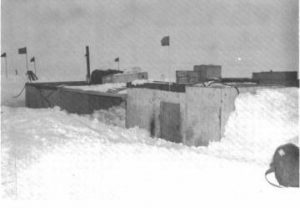 At the same time the station has been renamed “Little Jeana Summer Weather Station” and officially opened on 5 October 1964. The installation consists of 4 portable units, 3 of which are arranged in a “U”. In one are the sleeping and eating quarters for the 3-mandetach-ment; in another are a diesel generator and a workshop; while the third contains another generator and a wash room.
At the same time the station has been renamed “Little Jeana Summer Weather Station” and officially opened on 5 October 1964. The installation consists of 4 portable units, 3 of which are arranged in a “U”. In one are the sleeping and eating quarters for the 3-mandetach-ment; in another are a diesel generator and a workshop; while the third contains another generator and a wash room.
Picture aside (20 February 1964), shows an exterior view of berthing wanigan with messing wanigan in background at Little Rockford Summer Weather Station.
.
.
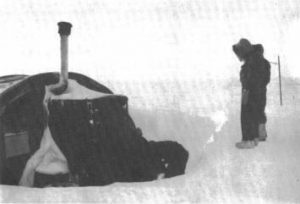 Wintering-over party shovelling out the James-way but at Beardmore Summer Weather Station for activating the station. (29 September 1961.)
Wintering-over party shovelling out the James-way but at Beardmore Summer Weather Station for activating the station. (29 September 1961.)
The center of the “U” has been turned into a permawalk, and here the pibal dome is located. The fourth unit has communications equipment and is separated from the others sothat it may, if needed, serve as an emergency shelter.
Little Rockford was reestablished the same day Little Jeana was opened. This installation has consisted of wanigans that were put in position in 1958 by tractors from Little America and later moved to the present site by the same means. It is intended to remodel Little Rockford, along the lines of Little Jeana, later in the season.
Source: Bulletin of the Antarctic US Projects officer (Vol.6 number 2-1964) – Ricerca Google
More details are available at: https://amrc.ssec.wisc.edu/usap/brockton/NCDC-WBAN.TXT
Dates: 1964 October 01, through 1966 January 31Location: 81° 23’ 00” South, 170° 45’ 00” West on Ross Ice ShelfElevation: 178 feet POBvVIIndex and Errata (1).pdf
Little Jeana was a “summer weather station”.
Bulletin of the U. S. Antarctic Projects Officer – United States. Antarctic Projects Office – Google Books
Bulletin 1, December 1964, reports:
Beardmore station will be relocated at 81° 23’ 00” South, 170° 45’ 00” West and renamed Little Jeana Station .
Two of such stations, one on the flight path between McMurdo and Byrd was named Little Rockford, while on the flight path from McMurdo to Amundsen-Scott the other one was Little Jeana.
Bulletin 2, January 1965 says: Little Jeana Station officially opened 5 October 1964.
4 wanigans (Wanigan is by definition, a shelter used for sleeping, eating, or storage, often mounted in Antarctica on a sledge), typical formation 3 in U-shape, and the 4th one separated for communications and in case of emergency. These four pieces were the setup for the use of 3 people. 2 for 1800-gallon fuel tanks to be installed (bladder technology used instead).
Bulletin 4 says: “…. manned by 3 Navy aerographers who broadcast weather conditions hourly”. Summer support season = 1 October through 1 March.
Bulletin 5, 8 February 1965 says: Communications van returned to McMurdo, digging out of station commenced. On 24 February 1965 Little Jeana closed for the season, personnel and equipment moved to McMurdo, but as reported above, other documents clearly states the activities from Little Jeana were: 3 oct.64 to 23 feb.65, from 2 oct.65 to 31 oct.65 and again from dec. 1st 1965 to jan. 22nd 1966.
TNX Bill Ashley KF5BRB for his invaluable help
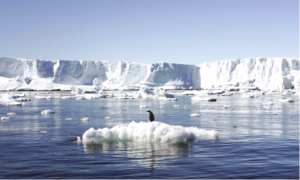 Dr Ruzica Dadic says there are complicated relationships between Antarctic snow and ice with feedback loops that need to be better understood as climate warms. The mysteries of how snow affects Antarctic sea ice remain largely unknown.
Dr Ruzica Dadic says there are complicated relationships between Antarctic snow and ice with feedback loops that need to be better understood as climate warms. The mysteries of how snow affects Antarctic sea ice remain largely unknown.
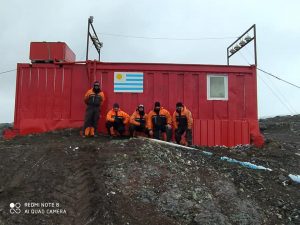 Uruguayan Ionospheric Refuge 62°10′59.4′′ South, 58°54′31.6′′ West, takes its name by Ionospheric Lake Uruguay in its proximity. Recently an Uruguayan crew put their manual skills on full blast, and in a great teamwork. They refurbished the shelter located about 800 meters from the Artigas Antarctic Scientific Base (WAP URY-Ø1), which can be used in case of evacuation.
Uruguayan Ionospheric Refuge 62°10′59.4′′ South, 58°54′31.6′′ West, takes its name by Ionospheric Lake Uruguay in its proximity. Recently an Uruguayan crew put their manual skills on full blast, and in a great teamwork. They refurbished the shelter located about 800 meters from the Artigas Antarctic Scientific Base (WAP URY-Ø1), which can be used in case of evacuation.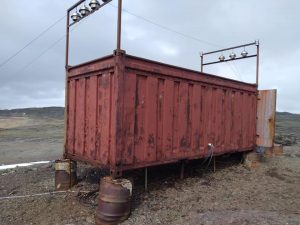
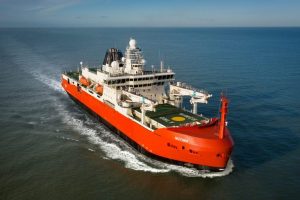 The design and build of the vessel has been a multi-national effort between the Australian Antarctic Division, the vessel operator Serco, Danish concept designers Knud E Hansen, Dutch engineering and detailed design team Damen, and the construction team at Damen Shipyards Galati in Romania.
The design and build of the vessel has been a multi-national effort between the Australian Antarctic Division, the vessel operator Serco, Danish concept designers Knud E Hansen, Dutch engineering and detailed design team Damen, and the construction team at Damen Shipyards Galati in Romania.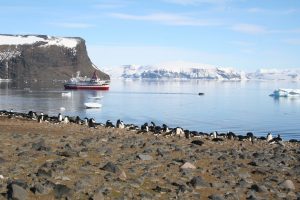 Ukraina whose presence in Antarctica is dated 1995-1996, has followed the 6Ø ATS (AntarcticTreaty Signature) celebration, by putting a Special Event Station on the air.
Ukraina whose presence in Antarctica is dated 1995-1996, has followed the 6Ø ATS (AntarcticTreaty Signature) celebration, by putting a Special Event Station on the air. This is the second time that a UK research asset has transferred to Ukrainian research colleagues. The first being the transfer in 1996 of the former Faraday Station
This is the second time that a UK research asset has transferred to Ukrainian research colleagues. The first being the transfer in 1996 of the former Faraday Station  DS4NMJ Lee, Sanghoon is still active as DT8A from King Sejong a year-round station , one of the two Korean Bases in Antarctica where he will operate until December 31st , 2021.
DS4NMJ Lee, Sanghoon is still active as DT8A from King Sejong a year-round station , one of the two Korean Bases in Antarctica where he will operate until December 31st , 2021.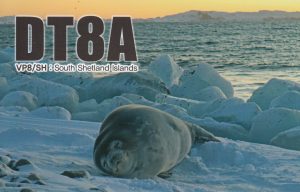
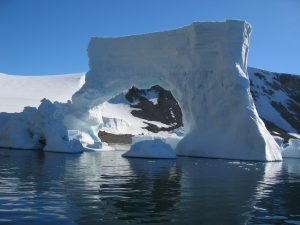 There is a nice article published on last June 2021 by “Science Focus”.
There is a nice article published on last June 2021 by “Science Focus”. Day by day, several Hams from different nations are showing up with Special callsigns to join the 6Ø years Anniversary of the Antarctic Treaty Signature.
Day by day, several Hams from different nations are showing up with Special callsigns to join the 6Ø years Anniversary of the Antarctic Treaty Signature.
 D Q 6 Ø A N T
D Q 6 Ø A N T A small group of Enthusiastic USKA members (Union of Swiss Shortwave Radio Amateurs) will put the special call sign HB6ØANT, in support and reminder that this contract will be preserved, on the airwaves beginning in mid-August through December 31, 2021.
A small group of Enthusiastic USKA members (Union of Swiss Shortwave Radio Amateurs) will put the special call sign HB6ØANT, in support and reminder that this contract will be preserved, on the airwaves beginning in mid-August through December 31, 2021. It was not an easy task to retrace the history of Little Jeana Station but thanks to our friend Bill Ashley KF5BRB who did provide a QSL ofthis rare one, WAP is now in condition to issue to LITTLE JEANA STATION (aka Little Jeana Summer Weather Station) a brand new WAP reference as USA-47.
It was not an easy task to retrace the history of Little Jeana Station but thanks to our friend Bill Ashley KF5BRB who did provide a QSL ofthis rare one, WAP is now in condition to issue to LITTLE JEANA STATION (aka Little Jeana Summer Weather Station) a brand new WAP reference as USA-47. At the same time the station has been renamed “Little Jeana Summer Weather Station” and officially opened on 5 October 1964. The installation consists of 4 portable units, 3 of which are arranged in a “U”. In one are the sleeping and eating quarters for the 3-mandetach-ment; in another are a diesel generator and a workshop; while the third contains another generator and a wash room.
At the same time the station has been renamed “Little Jeana Summer Weather Station” and officially opened on 5 October 1964. The installation consists of 4 portable units, 3 of which are arranged in a “U”. In one are the sleeping and eating quarters for the 3-mandetach-ment; in another are a diesel generator and a workshop; while the third contains another generator and a wash room. Wintering-over party shovelling out the James-way but at Beardmore Summer Weather Station for activating the station. (29 September 1961.)
Wintering-over party shovelling out the James-way but at Beardmore Summer Weather Station for activating the station. (29 September 1961.)